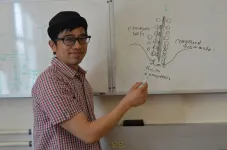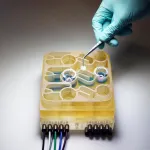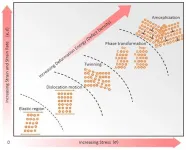(Press-News.org) Boulder, Colo., USA: GSA's dynamic online journal, Geosphere, posts articles online regularly. Topics for articles posted for Geosphere this month include feldspar recycling in Yosemite National Park; the Ragged Mountain Fault, Alaska; the Khao Khwang Fold and Thrust Belt, Thailand; the northern Sierra Nevada; and the Queen Charlotte Fault.
Feldspar recycling across magma mush bodies during the voluminous Half Dome and Cathedral Peak stages of the Tuolumne intrusive complex, Yosemite National Park, California, USA
Louis F. Oppenheim; Valbone Memeti; Calvin G. Barnes; Melissa Chambers; Joachim Krause ...
Abstract: Incremental pluton growth can produce sheeted complexes with no magma-magma interaction or large, dynamic magma bodies communicating via crystal and melt exchanges, depending on pulse size and frequency of intrusions. Determining the degree and spatial extent of crystal-melt exchange along and away from plutonic contacts at or near the emplacement level, such as in the large, long-lived Tuolumne intrusive complex (TIC) in California, sheds light onto the process and evolution of incremental growth. This study used field mapping and petrographic and geochemical analysis of plagioclase and K-feldspar populations in the equigranular Half Dome (eHD), porphyritic Half Dome (pHD), and Cathedral Peak (CP) Granodiorites of the southeastern section of the TIC to determine the presence and/or extent of feldspar recycling at interunit contacts. Our results suggest that contacts between major units are predominantly ~400-m- to 3-km-thick gradational zones. K-feldspar is compositionally distinct in eHD and neighboring gradational zones and shows no evidence of mixing. K-feldspar in a gradational zone between pHD and CP shows evidence of mixing between the two. Plagioclase in eHD and CP display distinct ranges of anorthite content, Sr, and light rare earth element abundances; both populations are observed in pHD. Major oxide and trace element calculations of melts in equilibrium with plagioclase cores indicate that the melts were more silicic, less calcic, and lower in Sr and Rb than corresponding analyzed whole-rock samples. These results suggest that the magmas also underwent plagioclase and biotite accumulation. The presence of two plagioclase populations in pHD is consistent with eHD and CP hybridizing to form pHD in an increasingly maturing and exchanging TIC magmatic system during the eHD-pHD-CP stages but before groundmass and small K-feldspar phenocrysts crystallized.
View article: https://pubs.geoscienceworld.org/gsa/geosphere/article-abstract/doi/10.1130/GES02286.1/594155/Feldspar-recycling-across-magma-mush-bodies-during
Development of surface ruptures by hanging-wall extension over a thrust ramp along the Ragged Mountain fault, Katalla, Alaska, USA: Applications of high-resolution three-dimensional terrain models
Sarah N. Heinlein; Terry L. Pavlis; Ronald L. Bruhn
Abstract: High-resolution three-dimensional terrain models are used to evaluate the Ragged Mountain fault kinematics (Katalla, Alaska, USA). Previous studies have produced contradictory interpretations of the fault's kinematics because surface ruptures along the fault are primarily steeply dipping, uphill-facing normal fault scarps. In this paper, we evaluate the hypothesis that these uphill-facing scarps represent extension above a buried thrust ramp. Detailed geomorphic mapping along the fault, using 20-cm-resolution aerial imagery draped onto a 1-m-resolution lidar (light detection and ranging) elevation model, was used to produce multiple topographic profiles. These profiles illustrate scarp geometries and prominent convex-upward topographic surfaces, indicating significant disturbance by active tectonics. A theoretical model is developed for fault-parallel flow over a thrust ramp that shows the geometric relationships between thrust displacement, upper-plate extension, and ramp dip. An important prediction of the model for this study is that the magnitude of upper-plate extension is comparable to, or greater than, the thrust displacement for ramps with dips greater than ~45°. This model is used to analyze profile shapes and surface displacements in Move software (Midland Valley Ltd.). Analyses of scarp heights allow estimates of hanging-wall extension, which we then use to estimate slip on the underlying thrust via the model. Assuming a low-angle (30°) uniformly dipping thrust and simple longitudinal extension via normal faulting, variations in extension along the fault would require a slip gradient from ~8 m in the north to ~22 m in the south. However, the same north-south variation in extension with a constant slip of 8-10 m may infer an increase in fault dip from ~30° in the north to ~60° in the south. This model prediction has broader implications for active-fault studies. Because the model quantifies relationships between hanging-wall extension, fault slip, and fault dip, it is possible to invert for fault slip in blind thrust ramps where hanging-wall extension is the primary surface manifestation. This study, together with results from the St. Elias Erosion and Tectonics Project (STEEP), clarifies the role of the Ragged Mountain fault as a contractional structure within a broadly sinistral shear system in the western syntaxis of the St. Elias orogeny.
View article: https://pubs.geoscienceworld.org/gsa/geosphere/article-abstract/doi/10.1130/GES02097.1/594156/Development-of-surface-ruptures-by-hanging-wall
Development of an intra-carbonate detachment during thrusting: The variable influence of pressure solution on deformation style, Khao Khwang Fold and Thrust Belt, Thailand
C.K. Morley; S. Jitmahantakul; C. von Hagke; J. Warren; F. Linares
Abstract: Classic detachment zones in fold and thrust belts are generally defined by a weak lithology (typically salt or shale), often accompanied by high over-pressures. This study describes an atypical detachment that occurs entirely within a relatively strong Permian carbonate lithology, deformed during the Triassic Indosinian orogeny in Thailand under late diagenetic-anchimetamorphic conditions. The key differences between stratigraphic members that led to development of a detachment zone are bedding spacing and clay content. The lower, older, unit is the Khao Yai Member (KYM), which is a dark-gray to black, well-bedded, clay-rich limestone. The upper unit, the Na Phra Lan Member (NPM), comprises more massive, medium- to light-gray, commonly recrystallized limestones and marble. The KYM displays much tighter to even isoclinal, shorter-wavelength folds than the NPM. Pressure solution played a dominant role throughout the structural development--first forming early diagenetic bedding; later tectonic pressure solution preferentially followed this bedding instead of forming axial planar cleavage. The detachment zone between the two members is transitional over tens of meters. Moving up-section, tight to isoclinal folds with steeply inclined axial surfaces are replaced by folds with low-angle axial planes, thrusts, and thrust wedging, bed-parallel shearing, and by pressure solution along bedding-parallel seams (that reduce fold amplitude). In outcrops 100-300 m long, reduction of line-length shortening on folds from >50% to END
Current issue articles for Geosphere posted online in January
2021-01-29
ELSE PRESS RELEASES FROM THIS DATE:
Women who develop high blood pressure after birth at greater risk of chronic hypertension
2021-01-29
Washington, DC — Blood pressure that remains elevated over of time — known as chronic hypertension — has been linked to heart disease, which is the leading cause of death in the United States. Recent research has shown that persistent high blood pressure may also increase the risk for stroke and overall mortality. Yet, only about 1 in 4 adults with chronic hypertension have their condition under control, according to the Centers for Disease Control and Prevention.
In a new study to be presented today at the Society for Maternal-Fetal Medicine's (SMFM) annual meeting, The Pregnancy Meeting™, researchers from the University of Pittsburgh will unveil findings that suggest that women who develop high blood pressure during pregnancy and who continue ...
A third of Americans say they are unlikely or hesitant to get COVID-19 vaccine
2021-01-29
News reports indicate COVID-19 vaccines are not getting out soon enough nor in adequate supplies to most regions, but there may be a larger underlying problem than shortages. A University of California, Davis, study found that more than a third of people nationwide are either unlikely or at least hesitant to get a COVID-19 vaccine when it becomes available to them.
The results are from public polling of more than 800 English-speaking adults nationwide in a study published online earlier this month in the journal Vaccine.
"Our research indicates that vaccine uptake will be suboptimal ... with 14.8 percent of respondents being unlikely to get vaccinated ...
Turning on the switch for plasticity in the human brain
2021-01-29
WOODS HOLE, Mass. -- The most powerful substance in the human brain for neuronal communication is glutamate. It is by far the most abundant, and it's implicated in all kinds of operations. Among the most amazing is the slow restructuring of neural networks due to learning and memory acquisition, a process called synaptic plasticity. Glutamate is also of deep clinical interest: After stroke or brain injury and in neurodegenerative disease, glutamate can accumulate to toxic levels outside of neurons and damage or kill them.
Shigeki Watanabe of Johns Hopkins University School of Medicine, a familiar face at the Marine Biological Laboratory (MBL) as a faculty member and researcher, is hot on the ...
Scientists solve long-standing mystery by a whisker
2021-01-29
RIVERSIDE, Calif. -- When we step on the car brake upon seeing a red traffic light ahead, a sequence of events unfolds in the brain at lightning speed.
The image of the traffic light is transferred from our eyes to the visual cortex, which, in turn, communicates to the premotor cortex -- a section of the brain involved in preparing and executing limb movements. A signal is then sent to our foot to step on the brake. However, brain region that helps the body go from "seeing" to "stepping" is still a mystery, frustrating neuroscientists and psychologists.
To unpack this "black box," a team of neuroscientists at the University of California, Riverside, has ...
Forecast :125,000 fewer U.S. COVID deaths if 50% initiate vaccination by March 1
2021-01-29
A new report combining forecasting and expert prediction data, predicts that 125,000 lives could be saved by the end of 2021 if 50% or more of the U.S. population initiated COVID vaccination by March 1, 2021.
"Meta and consensus forecast of COVID-19 targets," developed by Thomas McAndrew, a computational scientist and faculty member at Lehigh University's College of Health, and colleagues, incorporates data from experts and trained forecasters, combining their predictions into a single consensus forecast. In addition McAndrew and his team produce a metaforecast, which is a combination of an ensemble of computational models and their consensus forecast.
In addition to predictions related to the impact of vaccinations, ...
Accurate drug dosages with proton traps
2021-01-29
Researchers at Linköping University, Sweden, have developed a proton trap that makes organic electronic ion pumps more precise when delivering drugs. The new technique may reduce drug side effects, and in the long term, ion pumps may help patients with symptoms of neurological diseases for which effective treatments are not available. The results have been published in Science Advances.
Approximately 6% of the world's population suffer from neurological diseases such as epilepsy, Parkinson's disease, and chronic pain. However, currently available drug delivery methods - mainly tablets and injections - place the drug in locations where it is not required. This can lead to side effects ...
Our gut-brain connection
2021-01-29
CAMBRIDGE, MA -- In many ways, our brain and our digestive tract are deeply connected. Feeling nervous may lead to physical pain in the stomach, while hunger signals from the gut make us feel irritable. Recent studies have even suggested that the bacteria living in our gut can influence some neurological diseases.
Modeling these complex interactions in animals such as mice is difficult to do, because their physiology is very different from humans'. To help researchers better understa nd the gut-brain axis, MIT researchers have developed an "organs-on-a-chip" system that replicates interactions between the brain, liver, and colon.
Using that system, the researchers were able to model the influence that microbes living in the gut have on both healthy brain tissue and tissue samples derived ...
Islands without structure inside metal alloys could lead to tougher materials
2021-01-29
An international team of researchers produced islands of amorphous, non-crystalline material inside a class of new metal alloys known as high-entropy alloys.
This discovery opens the door to applications in everything from landing gears, to pipelines, to automobiles. The new materials could make these lighter, safer, and more energy efficient.
The team, which includes researchers from the University of California San Diego and Berkeley, as well as Carnegie Mellon University and University of Oxford, details their findings in the Jan. 29 issue of Science Advances.
"These present ...
Genes that dance to the circadian rhythm
2021-01-29
In 2017, the Nobel Prize in Physiology or Medicine went to three scientists who uncovered the molecular mechanisms that control the circadian rhythm, otherwise known as the "wake-sleep" cycle. To carry out their work, the scientists used the common fruit fly Drosophila melanogaster, making this the sixth Nobel to be awarded to research involving it.
Fruitful fruit flies
Life scientists have been using Drosophila for over a century now. First proposed by entomologist Charles W. Woodworth as a model organism, its use in research was pioneered by geneticist Thomas H. Morgan who ran his famous ...
Dewdrops on a spiderweb reveal the physics behind cell structures
2021-01-29
As any cook knows, some liquids mix well with each other, but others do not. For example, when a tablespoon of vinegar is poured into water, a brief stir suffices to thoroughly combine the two liquids. However, a tablespoon of oil poured into water will coalesce into droplets that no amount of stirring can dissolve. The physics that governs the mixing of liquids is not limited to mixing bowls; it also affects the behavior of things inside cells. It's been known for several years that some proteins behave like liquids, and that some liquid-like proteins don't mix together. However, very little is known about how these liquid-like proteins behave on cellular surfaces.
"The separation between two liquids that won't mix, like oil and water, is known as ...




